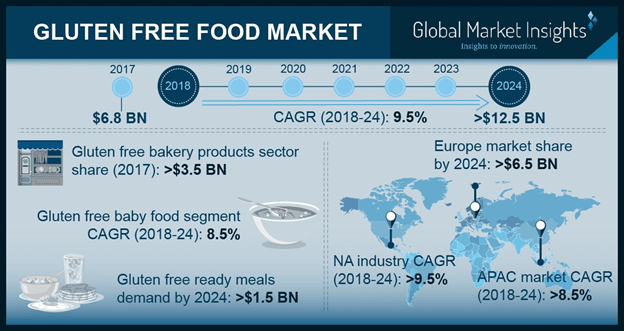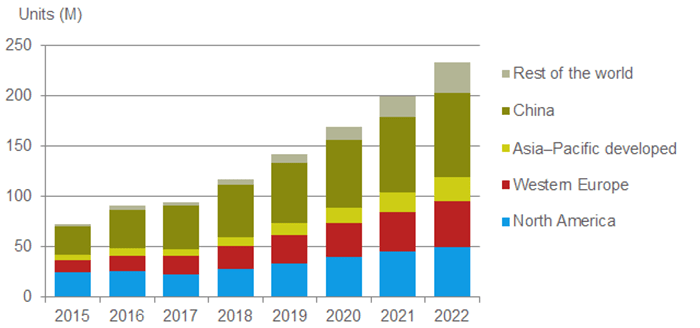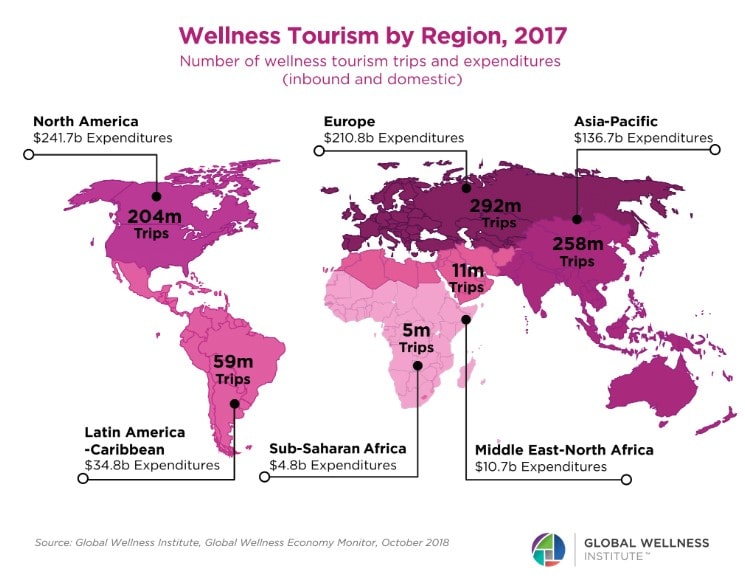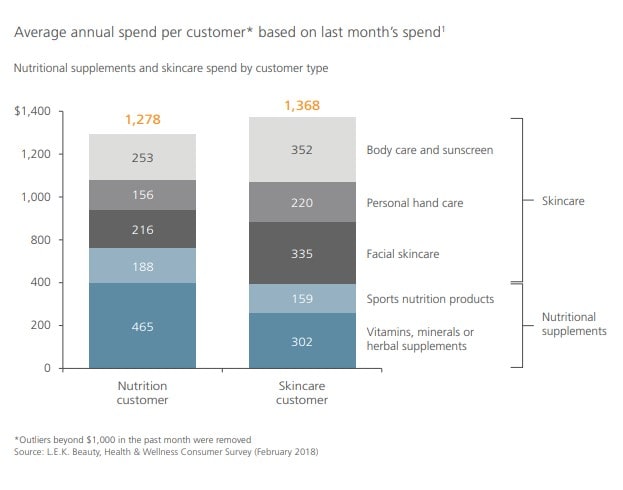According to the Global Wellness Institute, the global health and wellness industry is now worth $4.2 trillion.
The industry has been growing with 12.8% between 2015 and 2017 and represents 5.3% of global economic output.
The Health and Wellness industry encompasses all activities which promote physical and mental wellbeing: from yoga to healthy eating, personal care and beauty, nutrition and weight-loss, meditation, spa retreats, workplace wellness and wellness tourism.
Once upon a time, our contact with wellness was occasional: we went to the gym or got a massage. But this is changing fast: a wellness mindset is starting to permeate the global consumer consciousness, affecting people’s daily decision-making – whether food purchases, a focus on mental wellness and reducing stress, incorporating movement into daily life, environmental consciousness, or their yearning for connection and happiness. Wellness, for more people, is evolving from rarely to daily, from episodic to essential, from a luxury to a dominant lifestyle value. And that profound shift is driving powerful growth.
Katherine Johnston, senior research fellow, GWI
Read more: The Health and Fitness Industry Is Estimated To Reach $100 Billion in 2019
What is driving the growth of the health and wellness industry?
Here are 4 factors driving the growth of the Health and Wellness industry:
1. The clean eating trend – free-from and organic foods
Consumers are increasingly focused on living longer and healthier. Healthy living starts with healthy eating.
The consumer’s preferences have shifted towards eating more natural, free from additives or preservatives, organic food. Today eating clean means eating a diet made of gluten-free, dairy-free, non-refined carbs, sugar-free food.
Millions of people worldwide are suffering from the celiac disease which drives the demand for gluten-free/wheat free food market.
The global gluten-free retail market is estimated to grow to $12.5billion by 2024 at a rate of 9.5% from 2017.
According to Statista, Italy is the leading gluten-free and probiotics market in Europe.

image source: gminsights.com
2. Wearable devices and virtual assistants usher in the personalization of health and wellness
Demand has increased for all kinds of health-focused wearables: smartwatches, health and fitness trackers, heart rate monitors, apps which support the emotional and mental health of users and virtual assistants.
Learn more: This App Supports Your Employee’s Emotional Wellness
A 2018 Pricewaterhouse Coopers (PwC) report has found that almost half (49%) the people in the United States own a wearable device.
Health conscious consumers expect their wearable devices to help them live longer (70%), maintain a healthy weight (63%) and pay less in insurance premium (62%).
Wearables Market is expected to grow to $27 Billion by 2022.

image source: CSS Insights
3. Wellness tourism is growing
The wellness travel market is worth $639 billion and has been growing at a rate of 6.5% from 2015-2017. The growth rate for tourism overall is 3.2% so wellness travelling is growing twice as faster.
Wellness trips account for 17% of total tourism expenditures. Wellness seekers travel to Asia-Pacific, Latin America-Caribbean, Middle East-North Africa, and Sub-Saharan Africa to get in shape and return home relaxed and ready to go.
Over the past five years, Asia is the #1 destination of wellness travellers, attracting both trips and revenues.
In the last two years, trips to Asia grew by 33% to 258 million annually. China and India rank #1 and #2 for growth worldwide, adding over 12 million and 17 million wellness trips respectively from 2015-2017.

4. Amazon – the consumers’ preferred channel for nutritional supplements and skincare
The 2018 Beauty, Health & Wellness Survey conducted by LEK highlights the latest trends and offers insights into consumer interest in nutritional supplements and skincare.
Here are the survey’s findings:
- Average consumer spend – more than $100 per month — totalling $1,300 a year on nutritional supplements such as vitamins, minerals, herbal and sports nutrition products, and skincare products such as creams, lotions and sunscreens;
- Gen Xers and boomers spend on nutritional supplements, while millennials spend on skincare;
- Personalization is trending also with nutritional supplements and skincare – 39% of Millennials and 36% of Gen Xers are highly interested in receiving personalized programs; these programs consist of selecting nutritional supplements tailored to their individual health needs or a custom skin care program augmented by a beauty box delivery each month;
- Amazon has established itself as the No. 1 preferred channel for nutritional supplements and No. 2 preferred channel for skincare.

image source: lek.com
If you enjoyed my article and would like to discover information on other growing industries, I invite you to read the previous materials on pet-food, gaming and health & fitness.
Join the Conversation
We’d love to hear what you have to say.
Get in touch with us on Facebook Group and Twitter.



















